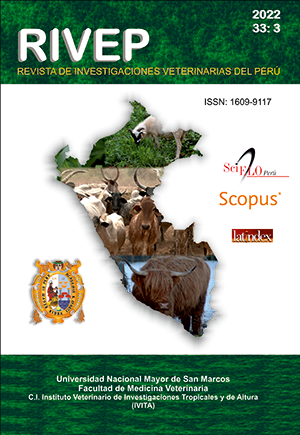Sedative effect of an alcoholic extract of Valeriana sp in tilapia fingerlings (Oreochromis niloticus) to reduce stress during simulated transport
DOI:
https://doi.org/10.15381/rivep.v33i3.21063Keywords:
fingerlings, stress, sedation, simulated transportAbstract
The aim of this study was to evaluate the sedative effect of three products: valerian extract (Valeriana officinalis), benzocaine and tricaine methanesulfonate (MS-222) on stress levels produced by a simulated transport model in tilapia fingerlings. In a first part, the sedative dose of the products was determined based on the clinical characteristics that indicate depression of the central nervous system. In the second part, sedation and subsequent simulated transport for 3 hours were performed. The fish were euthanized, and blood samples were taken from the tail vein to determine cortisol (ELISA) and glucose (portable glucometer) levels, haematological parameters and mortality. The optimal doses of sedation were 200, 35 and 75 mg/l, respectively, for valerian extract, benzocaine and MS-222. After 3 h of simulated transport, cortisol and glucose values were similar or higher compared to the non-sedated control group. The haematocrit did not present significant variation (p>0.05) in the group treated with valerian, while the other treated groups presented lower values than the control (p<0.05). All the treated groups presented low total protein values (p<0.05) and none of the groups presented mortality. It was concluded that, although it was possible to establish a state of sedation in tilapia fingerlings with specific doses of benzocaine, MS-222 and valerian extract, the doses were not sufficient to reduce stress during simulated transport for 3 h.
Downloads
Downloads
Published
Issue
Section
License
Copyright (c) 2022 Tessy Montañez Calero, Diego Díaz Coahila, Pedro Angulo Herrera, Luis Cerro Temoche, César Cruz-Castellón, Wilfredo Vasquez-Quispesivana, César Aquiles Lázaro de la Torre

This work is licensed under a Creative Commons Attribution 4.0 International License.
AUTHORS RETAIN THEIR RIGHTS:
a. Authors retain their trade mark rights and patent, and also on any process or procedure described in the article.
b. Authors retain their right to share, copy, distribute, perform and publicly communicate their article (eg, to place their article in an institutional repository or publish it in a book), with an acknowledgment of its initial publication in the Revista de Investigaciones Veterinarias del Perú (RIVEP).
c. Authors retain theirs right to make a subsequent publication of their work, to use the article or any part thereof (eg a compilation of his papers, lecture notes, thesis, or a book), always indicating the source of publication (the originator of the work, journal, volume, number and date).










